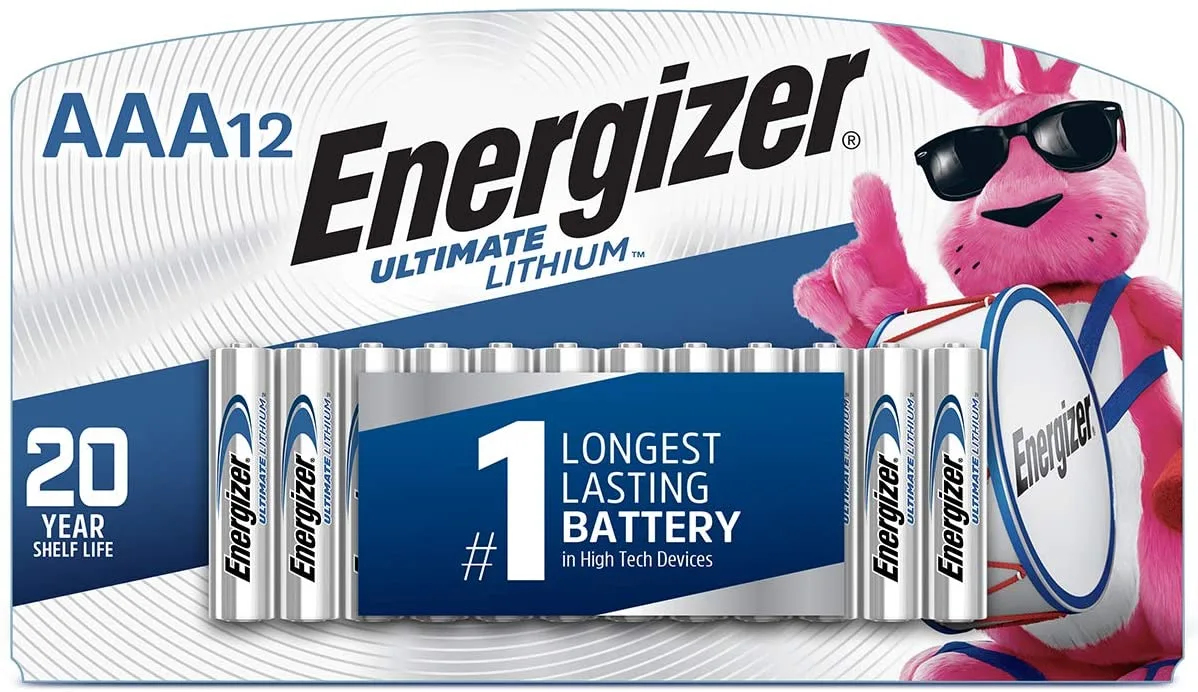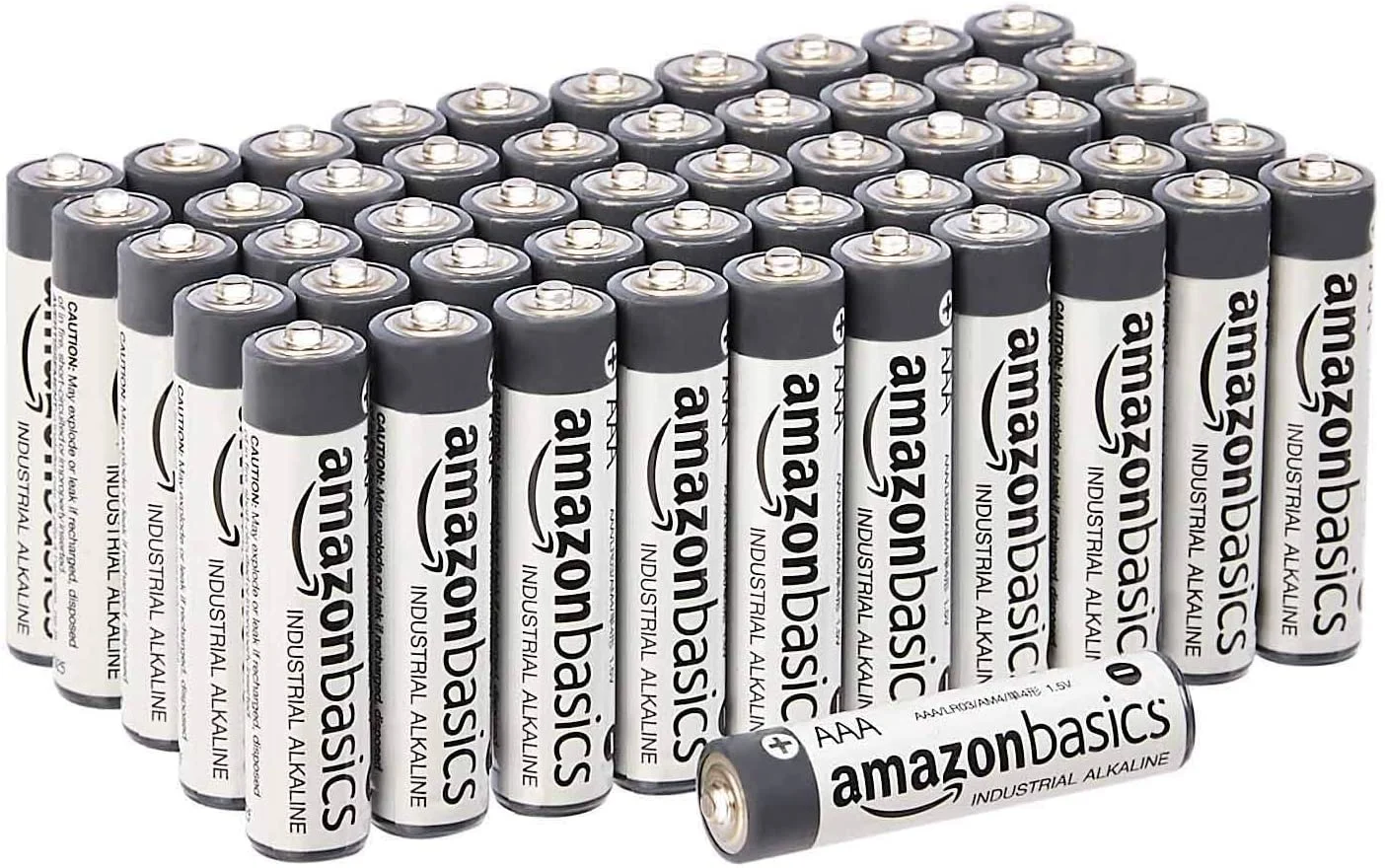_We may earn revenue from the products available on this page and participate in affiliate programs. Learn more ›
_
Best Alkaline for Shelf Life

Duracell Alkaline Batteries
LEARN MORE
Summary
Duralock technology keeps them fresh for 10 years.
Best Lithium for Shelf Life

Energizer Lithium Batteries
LEARN MORE
Summary
Still good 20 years after purchase.
Best Rechargeable

Panasonic Rechargeable Batteries
LEARN MORE
Summary
Can be recharged 2100 times.
The year is 1780, and Italian physician Luigi Galvani has a dead frog attached to a brass hook on the kitchen table. He and his wife were skinning the amphibian so they could rub its skin and produce static electricity. When the steel scalpel touched the amphibian, its leg twitched. Galvani was convinced that meant the frog was electrified, but his friend and fellow scientist Alessandro Volta wasn’t so sure. Volta thought the dead frog kicked because its body was a moist conductor between the hook and the scalpel—and he used that hypothesis to build a battery called the voltaic pile.
The battery started out as a series of wine goblets filled with super salty water into which Volta dropped electrodes. That confirmed that two metals and a salt solution are necessary to generate an electric current. And that’s the story of the first battery…or is it?
In the 1930s, archaeologists unearthed a mysterious clay jar in Iraq. The jar had an asphalt stopper and an iron rod shoved into a copper cylinder inside the jar—and when it was filled with vinegar, the jar generated over a volt of electricity. It turns out the jar was a 2,000-year-old battery probably used for electroplating around 250 B.C.
Contemporary batteries aren’t nearly as exciting as a series of goblets or an ancient clay mystery battery, but they’re way more convenient. Here’s what to look for when choosing the best AAA batteries for your various devices.
Best Alkaline Batteries for Shelf Life: Duracell Alkaline Batteries
Best Lithium Batteries for Shelf life: Energizer Lithium Batteries
Best Rechargeable: Panasonic Rechargeable Batteries
Best in Bulk Packaging: Rayovac Alkaline Batteries
Best Budget: AmazonBasics Alkaline Batteries
The Best AAA Batteries: Reviews & Recommendations
Best Alkaline Batteries for Shelf Life: Duracell Alkaline Batteries

Why It Made the Cut: A steel, zinc, and manganese alkaline battery that’s good for 10 years.
These long-lasting, mercury-free alkaline AAA batteries feature what Duracell calls Duralock Power Preserve Technology, which keep them fresh for 10 years in storage. They’re made in the USA and are ideal for use in remotes, flashlights, smoke detectors, and toys. You can buy small packs of them at a cost of less than a dollar a battery.
Best Lithium Batteries for Shelf life: Energizer Lithium Batteries

Why It Made the Cut: This high-tech battery lasts up to 20 years before expiring.
AAA lithium batteries are leak-proof and boast a shelf life of up to 20 years when stored properly. These are good for high-tech or smart devices that require more power to function over the long haul. They’re also a good choice for long-term storage—in a deer camp or summer home, say— or for backup for important high-tech devices in the home.
Best Rechargeable: Panasonic Rechargeable Batteries

Why It Made the Cut: This NiMH battery is good for 2,100 recharges and maintains 70 percent charge when stored for 10 years.
These nickel metal hybrid (NiMH) rechargeable batteries can be recharged over 2,000 times before they begin to break down. That makes them ideal for use in a device that you use often and goes through batteries, because you can rotate two sets of batteries for years.
Best in Bulk Packaging: Rayovac Alkaline Batteries

Why It Made the Cut: A bulk package of single-use alkaline batteries with a 10-year shelf life.
These AAA alkaline batteries are single use, making them ideal for low power devices, emergency kits, and times when the user can’t access electricity to recharge. The re-closable bulk package makes it easy to store unused batteries over the product’s 10-year shelf life.
Best Budget: AmazonBasics Alkaline Batteries
Best Budget

Why It Made the Cut: The single-use AAA batteries in this bulk package have a 10-year leak-free shelf life.
The AAA batteries feature an internal insulating ring that prevents short circuits and accidental discharge.
What to Consider When Choosing AAA Batteries
There are two major considerations when shopping: the type of battery (alkaline, lithium, or rechargeable), the battery’s expected shelf life, the price, and whether you prefer name brand or generic batteries.
The first consideration is single use versus rechargeable. Single-use batteries are generally classic alkaline or its lighter, longer lasting (but more expensive) cousin lithium. They will power your device for as long as the elements inside it last, and then you toss the dead battery into the trash or recycle it.
can drive their internal reactions backwards, resetting the battery so you can use it over and over for about 3 years.
Shelf life, cost, and brand name vs. generic are other considerations. Here’s what to know when deciding how long you need to store your batteries, how much money you want to spend at the outset, and whether a generic product meets your needs.
How Long Do You Need the Battery to Last?
Alkaline batteries use the same basic principle that governed Volta’s battery: two electrodes and a salt solution that lets ions flow between them. Those electrodes are what most people think of as the positive (anode) and negative (cathode) sides of the battery.
For modern alkaline batteries, the anode is usually zinc, and the cathode is manganese oxide. The movement of ions between the two generates the energy the battery uses to power your devices. This is a chemical reaction, and over time, the chemicals driving the reaction are used up, and the ions stop flowing. That’s a dead battery.
The metal electrodes also break down over time, and that battery won’t work even if it’s never been plugged into a device. That’s why batteries have expiration dates. Most of us keep a stock of batteries at home or in our vehicles so that we don’t have to hit the store the moment a flashlight or remote control quits on use, so it’s a good idea to consider a battery’s shelf life when making your choice. Many alkaline batteries have shelf lives that fall between 7 and 10 years. Alkaline batteries are less expensive than other battery types, making these a good choice for all-around use.
FAQs
Q: Are lithium batteries worth the cost?
Lithium batteries operate on the same basic principle as alkaline batteries, but use different elements to drive the chemical reaction. In this case, the cathode is a lithium compound, and the anode is carbon.
Lithium is a highly reactive element, which means it stores a lot of energy. And since AAA batteries are designed to hold exactly 1.5 volts of power, an energy-dense lithium battery can do that with fewer ingredients. That translates to a lightweight battery—about half the weight of equivalent alkaline batteries. They also have a much longer life. In fact, lithium single-use batteries boast double the shelf life—up to a whopping 20 years.
Single-use lithium batteries really shine when you want long battery life—crucial in a high-tech device—or plan to store the batteries on the shelf for a while. And they’re ideal if you want the device you’re powering to be as light as possible. The downside is that lithium batteries tend to be more expensive than their single-use alkaline cousins. Because lithium is so reactive, it’s also slightly more likely to discharge randomly (read: explode), but that’s more of an issue for rechargeable lithium-ion batteries used to power cell phones and laptops.
Q: Should I invest in rechargeable AAA batteries?
So, what about rechargeable batteries? This, too, is a chemistry lesson. Remember how the chemical reaction that takes place inside a battery eventually taps out the chemicals, and the flow of ions stops, leaving you with a dead battery? When plugged into an energy source, rechargeable batteries can run those chemical reactions backwards. That reverses the changes to the chemicals in the battery, and you wind up with a fresh battery.
This doesn’t last forever, of course. Over time, tiny bits of metal get stuck in the imperfections in the surface of rechargeable lithium batteries. triggering a reaction that builds up crystals. These get in the way of the ion flow, eventually making the battery so inefficient that it simply stops working. But that happens over about three years, so we’re talking hundreds of recharges.
Some rechargeable batteries generate energy using nickel and cadmium. Thanks to the properties of those elements, NiCd (typically referred to as NiCad) batteries can be used and recharged over a very long time—up to 20 years—which means you won’t need to consume as many batteries. However, it’s important to dispose of these batteries carefully. Cadmium is toxic to plants and animals and can cause harm if it seeps into the groundwater.
Rechargeable AAA batteries are more expensive than alkaline or lithium batteries, and you’ll have to invest in a recharger (which is often sold with the batteries), but they’re more economical over the long haul. That makes rechargeable batteries are a wise choice for any device that runs through batteries quickly. Get enough batteries so you can use one set in your device and keep another set fully charged. You won’t have any downtime.
Q: Are generic AAA batteries any good?
In general, generic products tend to be much cheaper when compared with the name brand option—but sometimes that name brand brings a measure of security about the quality or durability of the item. How does the name-brand versus generic question shake out when it comes to batteries?
Consumer Reports and a physics blogger at Wired researched this by hooking up numerous batteries to voltage and current testers and recording the results. It turns out that name brands do hold more energy per battery—up to 3 watt-hours versus less than 1 watt-hour. But the generic batteries were indeed much cheaper— so the price per watt-hour was basically a wash.
Their bottom line is that it probably makes sense to invest in name-brand batteries for devices that require a lot of power, or that you wouldn’t want to quit on you without warning. But for devices such as remote controls, or toys that a child will use often (or leave on, draining the batteries), inexpensive generic AAA batteries are a good choice.
Q: Is buying in bulk worthwhile?
The average household in the U.S. uses about 47 batteries per year
. That’s 188 single-use batteries over four years, or just 12 rechargeable batteries. When you look at that math, it seems like rechargeable batteries make the most sense, and that’s generally true—except when it isn’t.
Believe it or not, there are some instances where experts recommend sticking with old-school single-use batteries. This is true with devices that use very little power, such as headlamps or clocks. These may dim or keep time poorly when a rechargeable battery is almost out of juice. Battery-powered smoke alarms are optimized for single-use batteries, so they may not chirp if a rechargeable battery is low on power. It’s also a good idea to stick with single-use batteries for emergency kits and outdoor use, since these batteries may hold up better in harsher conditions.If you use a lot of triple A batteries, buying in bulk may minimize the per-battery expense and ensure a good stock of batteries for emergency circumstances. In general, bulk packages of triple A batteries clock in anywhere from two-thirds to one-half the price, per battery, of standard packages.
Final Thoughts on the Best AAA Batteries
When it comes to selecting the best AAA battery for a device, you need to consider how crucial the device is, how much power is required, if you’ll be keeping batteries in storage, and of course, the price. Single-use alkaline batteries are ideal for all-around use, while lithium batteries are powerful, lightweight, and last a long time. Rechargeable batteries are ideal for devices that go through batteries quickly, and buying an off-brand battery, or in bulk, will save you money over the long term if you use a lot of AAA batteries.
Why Trust Us
For more than 125 years, Field & Stream has been providing readers with honest and authentic coverage of outdoor gear. Our writers and editors eat, sleep, and breathe the outdoors, and that passion comes through in our product reviews. You can count on F&S to keep you up to date on the best new gear. And when we write about a product—whether it’s a bass lure or a backpack—we cover the good and the bad, so you know exactly what to expect before you decide to make a purchase.





